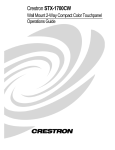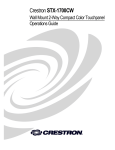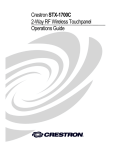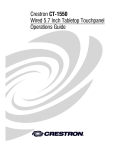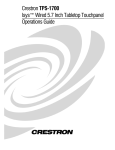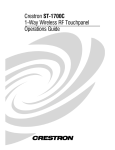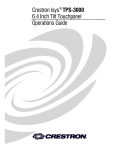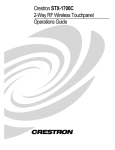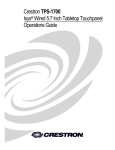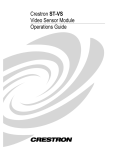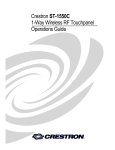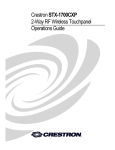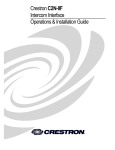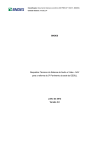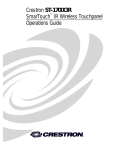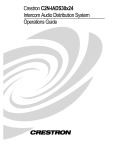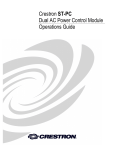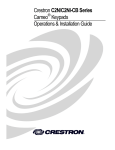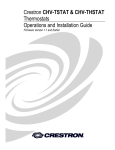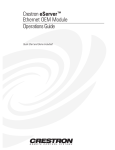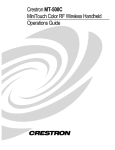Download Crestron ST-DSN Specifications
Transcript
Crestron ST-1700C 1-Way Wireless RF Touchpanel Operations Guide This document was prepared and written by the Technical Documentation department at: Crestron Electronics, Inc. 15 Volvo Drive Rockleigh, NJ 07647 1-888-CRESTRON All brand names, product names and trademarks are the property of their respective owners. ©2004 Crestron Electronics, Inc. Crestron ST-1700C 1-Way Wireless RF Touchpanel Contents 1-Way Wireless RF Touchpanel: ST-1700C 1 Introduction ............................................................................................................................... 1 Functions and Features ................................................................................................ 1 Specifications .............................................................................................................. 2 Physical Description.................................................................................................... 3 Industry Compliance ................................................................................................... 5 Setup .......................................................................................................................................... 5 Applying Power........................................................................................................... 5 Identity Codes.............................................................................................................. 6 Configuring the Touchpanel........................................................................................ 6 General Use and Safety ............................................................................................. 10 Recommended Touchpanel Cleaning ........................................................................ 10 Programming Software ............................................................................................................ 11 Earliest Version Software Requirements for the PC ................................................. 11 Programming with Crestron SystemBuilder.............................................................. 12 Programming with SIMPL Windows ........................................................................ 12 Programming with VT Pro-e ..................................................................................... 15 Virtual Feedback ....................................................................................................... 15 Optional Pushbuttons................................................................................................. 21 Reserved Join Numbers............................................................................................. 21 MultiByte International Characters ........................................................................... 22 Uploading and Upgrading........................................................................................................ 23 Communication Settings ........................................................................................... 23 Uploading a VT Pro-e Project ................................................................................... 27 Firmware Upgrade..................................................................................................... 28 Problem Solving ...................................................................................................................... 30 Troubleshooting......................................................................................................... 30 Further Inquiries ........................................................................................................ 31 Future Updates .......................................................................................................... 31 Appendix: Installation of Optional Pushbuttons..................................................................... 32 Software License Agreement................................................................................................... 33 Return and Warranty Policies .................................................................................................. 35 Merchandise Returns / Repair Service ...................................................................... 35 CRESTRON Limited Warranty................................................................................. 35 Operations Guide – DOC. 6225A Contents • i Crestron ST-1700C 1-Way Wireless RF Touchpanel 1-Way Wireless RF Touchpanel: ST-1700C Introduction Functions and Features The ST-1700C is a one-way wireless RF touchpanel that provides a user interface to a Crestron® control system (herein referred to as the Cresnet® system). The lightweight, hand-held touchpanel, with long-life NiMH battery and RF wireless communication with a range of up to 300 feet, allows complete freedom of movement, indoors or out. Customized graphic icons let users easily control any function. Included with the ST-1700C are a Crestron High Performance Rechargeable Battery Pack (ST-BTPN) and a Docking Station (ST-DSN) that docks the touchpanel and/or recharges the ST-BTPN. An external power pack (PW-1215 for domestic use or PWI-1215 for international use) is also provided to power the touchpanel. Refer to the latest revisions of the documentation supplied with these items for descriptions and details. The following table provides a functional summary of the ST-1700C. Functional Summary • • • • • • • • • • • Operations Guide – DOC. 6225A 5.7" (14.48 cm) active color matrix display 320 x 240 screen resolution 63MIPs ColdFire processor running Crestron Isys® generation firmware 16-bit non-palette graphics 64,000-color Crestron Isys engine 4 MB of Flash (3MB reserved for user display lists) 8 MB of SDRAM (Synchronous Dynamic RAM) for panel firmware Power up on last page Long-Life NiMH battery − fast charging − no battery memory Compatible with existing CNRFGWA RF gateway 1-Way RF communication, range up to 300 feet 1-Way Wireless RF Touchpanel: ST-1700C • 1 1-Way Wireless RF Touchpanel Crestron ST-1700C NOTE: The ST-1700C is supplied with an optional bezel, two 5-button switch actuators, and ten black pushbuttons (blank), five for each side of the LCD screen. You can use these buttons to access any frequently used commands. Refer to “Appendix: Installation of Optional Pushbuttons” for instructions to install the optional switches, buttons, and bezel. NOTE: Two options, 1700C-BTNB (black buttons) or 1700C-BTNS (silver buttons), can be purchased to provide custom engraved buttons for your touchpanel. Contact Crestron customer support for more information. Specifications Specifications for the ST-1700C are given in the following table. ST-1700C 1-Way Wireless RF Touchpanel Specifications SPECIFICATION Power Options ST-BTPN (or equivalent) AC: Domestic External Adapter AC: International External Adapter ST-DSN Default Net ID DETAILS Rechargeable NiMH battery pack (included) (4100 mAh capacity after full charge. Operating time 1 depends on usage.) 12VDC, 1.5A, 120VAC Input (included) (P/N PW-1215 or equivalent) 12VDC, 1.5A, 230VAC Input (included with international version touchpanel) (P/N PWI-1215 or equivalent) Docking Station/charger with external power pack (included) 3 Default RF ID 10 Default Timeouts 10 minutes for standby 30 minutes for power down Signal Join Maximums 999 digital Control System Update Files 2-Series Control System CEN/CN-TVAV CNMSX-AV/Pro CNRACKX/-DP ST-CP Acceptable File Extensions 2, 3, 4 Version C2-2004.CUZ or later Version 5.10.13V.UPZ or later Version 5.10.11X.UPZ or later Version 5.10.11W.UPZ or later Version 4.02.02S.UPZ or later 5 .vtz .csf projectname.vtz (compiled file) ST1700C.vx.xxx.x.csf (panel firmware) RF Specifications 1-Way Wireless RF Touchpanel, 433.92 MHz, Range 6 up to 300 feet Memory 4 MByte flash memory (3 Mbytes available for user programming) 8 MByte SDRAM for firmware storage EEPROM for NV storage of last page and join #s Touchscreen Dimensions Height: 3.700 in (9.017 cm) Touchscreen Resolution 320 x 240 pixels, 64K color ISYS engine Width: 4.700 in (11.938 cm) Touchscreen Viewing Angles ±65° for X dir, +65°/-40° for Y dir Touchscreen LCD Active matrix, 64K colors Touchscreen Illumination Backlit fluorescent Touchscreen Composition Resistive Membrane Operating Temperature 50° to 113°F (10° to 45°C) (continued on next page) 2 • 1-Way Wireless RF Touchpanel: ST-1700C Operations Guide – DOC. 6225A Crestron ST-1700C 1-Way Wireless RF Touchpanel ST-1700C 1-Way Wireless RF Touchpanel Specifications (continued) SPECIFICATION DETAILS Humidity 10% to 90% RH (non-condensing) Overall Dimensions Width: 8.75 in (22.23 cm) Height: 3.85 in (9.78 cm) Depth: 5.51 in (14.00 cm) Weight (without battery pack) 1.85 lb (0.84 kg) Battery life is 180 minutes continuous usage with background lighting at full brightness. Actual operating time depends on usage and settings for background brightness and timeouts. 2. The latest versions can be obtained from the Downloads | Software Updates section of the Crestron website (www.crestron.com). Refer to NOTE after last footnote. 3. Crestron 2-Series control systems include the AV2 and PRO2. Consult the latest Crestron Product Catalog for a complete list of 2-Series control systems. 4. CNX update files are required for either CNMSX-AV/PRO or CNRACKX/-DP. Filenames for CNX update files have a UPZ extension and ST-CP files are in one EXE or zipped UPZ file. To avoid program problems, make certain you are using the update file with the correct suffix letter (e.g., S, V, W, X). 5. Extension requires a prefix specific to the touchpanel type. In DETAILS, projectname represents the assigned project name, and vx.xxx.x represents a version number. 6. Requires Crestron CNRFGWA 1-Way RF Receiver, or ST-CP SmarTouch Control Processor. 1. NOTE: Crestron software and any files on the website are for Authorized Crestron dealers and Crestron Authorized Independent Programmers (CAIP) only. New users may be required to register to obtain access to certain areas of the site (including the FTP site). Physical Description The touchpanel has a 5.7-inch (14.48 cm) active matrix color display panel with 320 x 240 resolution and 16-bit non-palette graphics. The electronic hardware is housed in a black and silver molded plastic enclosure, shown below. Connectors to power the unit and upload touchscreen projects are located on the sides of the unit. Physical View of ST-1700C Operations Guide – DOC. 6225A 1-Way Wireless RF Touchpanel: ST-1700C • 3 1-Way Wireless RF Touchpanel Crestron ST-1700C Physical Views (continued) 5.01 in (12.73 cm) Top view 3.56 in (9.04 cm) 8.75 in (22.22 cm) Front view 5.70 in (14.48 cm) Side views 5.51 in (14.00 cm) 3.85 in (9.78 cm) 4.24 in (10.76 cm) Cresnet upload connector Power connector The battery compartment, located on the underside of the unit, holds one Crestron ST-BTPN, rechargeable power pack. There are also four rubber feet on the underside of the unit for stability and to prevent slippage. WARNING: To avoid shock hazard and possible damage to the unit, do not use touchpanel in rain or expose it to unnecessary moisture. 4 • 1-Way Wireless RF Touchpanel: ST-1700C Operations Guide – DOC. 6225A Crestron ST-1700C 1-Way Wireless RF Touchpanel Industry Compliance As of the date of manufacture, this unit has been tested and found to comply with specifications for CE marking and standards per EMC and Radio Communications Compliance Labeling. NOTE: This device complies with part 15 of the FCC rules. Operation is subject to the following two conditions: (1) this device may not cause harmful interference, and (2) this device must accept any interference received, including interference that may cause undesired operation. NOTE: This equipment has been tested and found to comply with the limits for a Class B digital device, pursuant to part 15 of the FCC Rules. These limits are designed to provide reasonable protection against harmful interference in a residential installation. The equipment generates, uses and can radiate radio frequency energy and, if not installed and used in accordance with the instructions, may cause harmful interference to radio communications. However, there is no guarantee that interference will not occur in a particular installation. If this equipment does cause harmful interference to radio or television reception, which can determined by turning the equipment off and on, the user is encouraged to try to correct the interference by one or more of the following measures: Reorient or relocate the receiving antenna. Increase the separation between the equipment and receiver. Connect the equipment into an outlet on a circuit different from that to which the receiver is connected. Consult the dealer or an experienced radio/TV technician for help. Setup Applying Power The touchpanel can be powered via the supplied external AC power pack, the ST-DSN docking station, or via the ST-BTPN battery pack. Each of these supplied items has its own guide which details proper usage. Refer to the following table for the required document number. NOTE: The battery can be charged only if the touchpanel is in the docking station. The touchpanel will function when powered by the external power pack, but this configuration will not charge the battery. Operations Guide – DOC. 6225A 1-Way Wireless RF Touchpanel: ST-1700C • 5 1-Way Wireless RF Touchpanel Crestron ST-1700C ST-1700C Power Source Options POWER SOURCE OPTION MODEL DOCUMENT NUMBER * Battery Pack** Docking Station Domestic External Power Pack or International External Power Pack ST-BTPN ST-DSN PW-1215 PWI-1215 6088 6095 5762 5763 * The latest revision may have a revision letter after the document number (i.e., 6088A). ** The battery pack does not “trickle” charge when the external power pack is used to power the touchpanel. Identity Codes The ST-1700C touchpanel uses two distinct types of identity codes: Cresnet identity (Net ID or Cresnet ID), and RF ID. These codes are assigned to the touchpanel from the Interface Submenu when the unit is configured. Refer to “Setup Menu” on page 7. For the touchpanel to be identified within the Cresnet system, these assignments must match assignments made in the SIMPL Windows program. Net ID Every equipment and user interface within the Cresnet system requires a unique Net ID. The Net ID is a two-digit hexadecimal number that can range from 03 to FE. The Net ID of the unit must match the Net ID specified in the SIMPL Windows program. The Net ID is used when the touchpanel is wired directly to the control system during uploading a Crestron VisionTools® Pro-e (VT Pro-e) project or upgrading the touchpanel firmware. RF ID Every ST-1700C touchpanel communicating with a Cresnet control system via a CNRFGWA requires a unique RF ID to secure RF communications. There are 15 useable codes (two-digit hexadecimal numbers) for multiple touchpanel(s) ranging from 10 to 0F in most significant digit increments (i.e., 10, 20, 30, . . . F0). The RF ID of the unit must match the RF ID specified in the SIMPL Windows program. NOTE: Do not set the RF ID to “00”; it is not supported in SIMPL Windows. Configuring the Touchpanel MAIN MENU To configure the unit, it may be necessary to access a series of setup screens prior to viewing run-time screens that are loaded into the touchpanel for normal operation. The MAIN MENU for configuring the touchpanel appears when a finger is held to the touchscreen for about five seconds from the powered down state. Upon entering SETUP MODE, the MAIN MENU, shown to the left, displays four buttons: Touch Screen Calibration, Exit and Run Program, Setup, and Diagnostics. This menu can also be obtained via digital reserved join number, 17242. The Exit and Run Program button verifies that all of the setup information has been saved to EEPROM and displays the main page that has been programmed into your system. The remaining buttons on the MAIN MENU open other menus, which are discussed in subsequent paragraphs. 6 • 1-Way Wireless RF Touchpanel: ST-1700C Operations Guide – DOC. 6225A Crestron ST-1700C 1-Way Wireless RF Touchpanel Calibration Menu CALIBRATION MENU Calibration of the touchscreen is required if the active touch area of a button does not coincide with the button's image. Select the Touch Screen Calibration button to display the CALIBRATION MENU, shown to the left. The CALIBRATION MENU offers the choice to initiate calibration with the Perform Calibration button or return to the previous screen with the Return button. Choose an option by touching the correct button. If you proceed to calibrate the touchpanel, the screen displays the message "Touch Upper Left" centered on the panel with a cross hair in the upper left corner. Touch the cross hair in the corner of the screen to initiate calibration. Another message, "Touch Upper right", appears with a cross hair in the correct corner. Touch the corner of the screen. A final message, “Touch Lower Left”, appears with a cross hair in the correct corner. Touch the corner of the screen to conclude calibration and return to the MAIN MENU. NOTE: When touching the screen during calibration, be as accurate as possible. Use the tip of a capped pen or the eraser end of a pencil. Setup Menu SETUP MENU To obtain the SETUP MENU, shown to the left, press the Setup button from the MAIN MENU. The SETUP MENU offers a series of buttons, which open additional menus and displays that are detailed in subsequent paragraphs. After setup parameters have been set, select the Return button to return to the MAIN MENU. NOTE: For convenience, the current CRESNET ID setting is displayed in the lower left corner. NOTE: All touchpanel settings are automatically saved in non-volatile memory. Battery Status BATTERY STATUS To access the BATTERY STATUS screen, shown to the left, press the Battery Status button on the SETUP MENU. This screen indicates the amount of charge (or life) remaining in the battery as a percentage of full capacity, if the battery is installed. An analog bar is provided below the percentage amount as a quick visual reference to the approximate level of charge remaining. The EXTERNAL POWER label appears if external power is applied either through the docking station or via the optional power pack. Note that battery recharging takes place only through the docking station. Touch the Return button to display the SETUP MENU. NOTE: When the touchpanel is in the docking station to recharge the battery, the % CAPACITY display is not an accurate indicator of battery charge level. The display will indicate a full charge (100%) before charging is actually complete. The docking station indicates that charging is complete by illuminating the RDY indicator. Operations Guide – DOC. 6225A 1-Way Wireless RF Touchpanel: ST-1700C • 7 1-Way Wireless RF Touchpanel Crestron ST-1700C Select Interface SELECT INTERFACE The touchpanel communicates with a control system to activate commands or to display feedback from components within the system. The communication interface must be correctly specified or communication will not occur. To set communication parameters, first select the Interface button on the SETUP MENU to display the SELECT INTERFACE screen, shown to the left. Then, select either the CRESNET or the RF button to display the CRESNET INTERFACE MENU or the SELECT RF ID screen, respectively. Use these screens to set the Cresnet network identity (Net ID) and the RF ID numbers. CRESNET INTERFACE MENU Cresnet Interface Menu CRESNET ID is a two-digit hexadecimal number that can range from 03 to FE, used only during screen uploads to the touchpanel or upgrading the touchpanel firmware. Net ID for the ST-1700C is factory set to 03. The UP and DOWN buttons increase and decrease the CRESNET ID by one digit (i.e., 03, 04, 05, . . . FE). Select the Return button to return to the SELECT INTERFACE screen. SELECT RF ID RF Setup RF ID, the radio frequency identity number, is necessary to secure RF communications such that controls can be activated from the touchpanel. The RF ID consists of a two-digit hexadecimal number. The touchpanel can be set to one of fifteen numbers; “10” is shown as an example in the illustration and happens to be the default. The RF ID setting should match the value assigned to the ST-1700C touchpanel definition is the SIMPL Windows program. Refer to page 12 for information about SIMPL programming/setup for this touchpanel. The UP and DOWN buttons increase and decrease the RF ID most significant digit by one, respectively (i.e., 10, 20, 30, …, F0). After the Cresnet ID and RF ID settings have been verified, touch the Return button to save the settings and display the SELECT INTERFACE screen. KEY CLICK SETUP SCREEN Key Click Setup From the SETUP MENU, press the Key Click Enabled button to open the KEY CLICK SETUP screen. (If the function is currently disabled, the button legend is “Key Click Disabled.”)To enable an audible tone (beep) when the touchpanel buttons are pressed, select among the Short, Med, or Long KEY CLICK ENABLE/LEN buttons to set the duration of the tone. The touchpanel responds with a corresponding signal. To disable the feature, select Click Off. Use the KEY CLICK VOLUME UP and DOWN buttons to increase and decrease the volume of the signal. The display to the right of the buttons shows the relative volume from 0% to 100%, both as a numeric value and, for a quick visual reference, as an analog bar. Select the Return button to return to the SETUP MENU. 8 • 1-Way Wireless RF Touchpanel: ST-1700C Operations Guide – DOC. 6225A Crestron ST-1700C SCREEN SETTINGS BRIGHTNESS 1-Way Wireless RF Touchpanel Brightness From the SETUP MENU, press the Brightness button to open the SCREEN SETTINGS – BRIGHTNESS screen. The UP and DOWN buttons increase and decrease screen brightness, respectively. The display to the right of the buttons shows the relative brightness from 0% to 100%. Select the Return button to return to the SETUP MENU. STARTUP PREFERENCE Startup Preference The Startup Preference feature allows (when the touchpanel is off or in standby) the display to come on or stay off when a “quick” pushbutton is pressed. From the SETUP MENU, press the Startup Preferences button to open the STARTUP PREFERENCE screen. NOTE: The “Display On From Hardkey” feature applies only to units with the 1700C-BTNB-BEZEL or 1700C-BTNB-BEZEL-BLANK option installed. These options provide for installation of a new bezel and ten “quick” pushbuttons, five on each side of the LCD screen. You can use these buttons to access any frequently used commands. For detailed information, refer to the latest version of the manual supplied with the options, Doc. 6224. When pressed, the DISPLAY ON FROM HARDKEY button toggles between ENABLED and DISABLED. With ENABLED selected, the display comes on when one of the “quick” pushbuttons is pressed. With DISABLED selected, the display stays off when a “quick” pushbutton is pressed (if touchpanel was off, it goes to standby). The default is DISABLED. The POWER UP ON LAST PAGE button also toggles between ENABLED and DISABLED. Enabling this option causes the unit to “remember” the last page and which “joins” were active when the unit was last powered down, and return to that state when next powered on. If the option is disabled, the unit will always go to the first page of the project and all “joins” are cleared. Select the Return button to return to the SETUP MENU. Power Management Timeout Settings POWER MANAGEMENT TIMEOUT SETTINGS The Power Management feature is intended to conserve energy and to extend the service life of the battery. From the STARTUP screen, press the Power Management button to display the POWER MANAGEMENT TIMEOUT SETTINGS Screen. Use the STANDBY and POWER DOWN UP and DOWN buttons to set the respective timeouts from 0 through 120 minutes, where 0 disables the timeout. The time settings are in single-minute increments from 0 to ten minutes, and in 10-minute increments from 10 minutes through 120 minutes. Use the Standby Now and Power Down Now buttons to immediately enter the respective mode. STANDBY timeout turns the display and backlight off when the touchpanel is inactive for the specified time. When the touchpanel is reactivated, the last screen to be displayed reappears. The specified time is displayed in minutes. The default STANDBY timeout is 10 minutes. Operations Guide – DOC. 6225A 1-Way Wireless RF Touchpanel: ST-1700C • 9 1-Way Wireless RF Touchpanel Crestron ST-1700C POWER DOWN timeout turns off all power when the touchpanel is inactive for the specified time. When the touchpanel is activated, either the first page of the project appears or the last screen to be displayed reappears, depending on the setting of the Power Up On Last Page option on the Startup Preference screen. The specified time is displayed in minutes. The default POWER DOWN timeout is 30 minutes. NOTE: Power Down Timeout should be set low to maximize battery life. However, Power Down Timeout should be set greater than Standby Timeout. Otherwise, the Standby Timeout is meaningless. NOTE: When the panel is powered down, it will take about 1.5 seconds to power up and respond to a button press. There is no such delay from Standby mode. NOTE: If the external AC power pack is attached to the touchpanel and plugged into an active AC receptacle, or if the touchpanel is resting in the docking station (ST-DSN) and plugged into an active AC receptacle, the panel does not power down when the power down timeout is achieved. Recall that the purpose of this timeout is to maximize battery life. Standby timeout still functions. Press Return to save the settings and return to the SETUP MENU. Diagnostics Menu DIAGNOSTICS MENU The Diagnostics button from the MAIN MENU should only be used under supervision from a Crestron customer service representative during telephone support. Many options available from the DIAGNOSTICS MENU, shown to the left, are numeric in nature and their interpretation is beyond the scope of this manual. General Use and Safety WARNING: To avoid shock hazard and possible damage to the unit, do not use the touchpanel in the rain or expose it to unnecessary moisture. Recommended Touchpanel Cleaning Keep the surface of the touchscreen free of dirt, dust, or other materials that could degrade optical properties. Long-term contact with abrasive materials can scratch the surface that may detrimentally affect image quality. For best cleaning results, use a clean, damp, non-abrasive cloth with any commercially available non-ammonia glass cleaner. Surrounding plastic enclosure may not provide a complete watertight seal. Therefore, apply cleaning solution to the cloth rather than the surface of the touchscreen. Wipe touchscreen clean and avoid ingress of moisture beneath panels. 10 • 1-Way Wireless RF Touchpanel: ST-1700C Operations Guide – DOC. 6225A Crestron ST-1700C 1-Way Wireless RF Touchpanel Programming Software Have a question or comment about Crestron software? Answers to frequently asked questions (FAQs) can be viewed in the Online Help section of the Crestron website (www.crestron.com). To post your own question or view questions you have submitted to Crestron’s True Blue Support, log in at http://www.crestron.com/accounts/login.asp. First-time users will need to establish a user account. You can create a program that allows you to set up the ST-1700C to operate a Crestron control system using the Crestron programming tools Crestron SystemBuilder™ and SIMPL Windows. These tools are intended for users with different levels of programming knowledge. The flexibility of each tool is proportional to the degree of programming expertise (i.e., the more flexible, the more a programmer needs to know and account for). Of course, one can initiate programming using the easiest method (SystemBuilder) and use advanced techniques that are available from SIMPL Windows to customize the job. VT Pro-e is a Windows compatible software package for creating Crestron touchpanel screen designs. Refer to “Programming with VT Pro-e” on page 15 for additional details regarding VT Pro-e. Earliest Version Software Requirements for the PC NOTE: Crestron recommends that you use the latest software to take advantage of the most recently released features. The latest software is available from the Downloads | Software Updates section of the Crestron website (www.crestron.com). The following are recommended software version requirements for the PC: Operations Guide – DOC. 6225A • SystemBuilder version 1.02 or later. Requires SIMPL Windows and Crestron Engraver. Requires SystemBuilder templates 1.01 or later. • SIMPL Windows version 2.05.22 or later. Requires SIMPL+ Cross Compiler version 1.1. • Crestron Database version 16.2.1 or later. Required by SIMPL Windows. • VisionTools Pro-e version 3.2.1.8 or later. Used for graphical touchscreen design. • (Optional) Crestron Engraver version 2.3.0.0 (only required if using SystemBuilder or if optional hard buttons and bezel are installed, and 1700C-BTNB or 1700C-BTNS engraveable button kits are purchased). 1-Way Wireless RF Touchpanel: ST-1700C • 11 1-Way Wireless RF Touchpanel Crestron ST-1700C Programming with Crestron SystemBuilder The easiest method of programming, but does not offer as much flexibility as SIMPL Windows. Crestron SystemBuilder offers automatic programming for such residential and commercial applications as audio distribution, home theater, video conferencing, and lighting. The interface of this tool guides you through a few basic steps for designating rooms and specifying the control system, touchpanels, devices, and functionality. Crestron SystemBuilder then programs the system, including all touchpanel projects and control system logic. Crestron SystemBuilder is fully integrated with Crestron's suite of software development tools, including SIMPL Windows, VT Pro-e, Crestron Engraver, Crestron Database, User IR Database, and User Modules Directory. Crestron SystemBuilder accesses these tools behind the scenes, enabling you to easily create robust systems. Programming with SIMPL Windows NOTE: The following assumes that the reader has knowledge of SIMPL Windows. If not, refer to the extensive help information provided with the software. NOTE: In the following description, the PRO2 control system is used. SIMPL Windows is Crestron's software for programming Crestron control systems. It provides a well-designed graphical environment with a number of workspaces (i.e., windows) in which a programmer can select, configure, program, test, and monitor a Crestron control system. SIMPL Windows offers drag and drop functionality in a familiar Windows® environment. This section describes a sample SIMPL Windows program that includes a touchpanel. Configuration Manager is where programmers “build” a Crestron control system by selecting hardware from the Device Library. In Configuration Manager, drag the PRO2 from the Control Systems folder of the Device Library and drop it in the upper pane of the System Views. The PRO2 with its associated communication ports is displayed in the System Views upper pane. PRO2 System View The System Views lower pane displays the PRO2 system tree. This tree can be expanded to display and configure the communications ports. 12 • 1-Way Wireless RF Touchpanel: ST-1700C Operations Guide – DOC. 6225A Crestron ST-1700C 1-Way Wireless RF Touchpanel Expanded PRO2 System Tree C2Net-Device Slot in Configuration Manager To incorporate a wireless RF touchpanel into the system, a gateway device is required. The C2Net-Device Slot can accept a gateway such as the CNRFGWA. Once a gateway is configured in a C2Net-Device Slot, the slot allows Cresnet communication between the touchpanel and the control system. In Configuration Manager, drag the CNRFGWA gateway from the Wireless Receivers (RF) folder of the Device Library. The System Views upper pane displays the CNRFGWA device icon below the PRO2 graphic. NOTE: An ST-CP control processor is automatically configured with a CNRFGWA in its STCP-Net Device Slot 3, with a fixed Net ID of 2, when the ST-CP is dragged into the upper pane of System Views. Drag the ST-1700C from the Touchpanels (Wireless | Wireless one way) folder of the Device Library and drop it on the CNRFGWA symbol in System Views. The PRO2 system tree displays the CNRFGWA gateway in Slot 9, with a default Net ID of 24. The CNRFGWA displays the touchpanel at the touchpanel’s default RF ID location, “10,” as shown in the following illustration. C2Net Device, Slot 9 Double-click the CNRFGWA icon in the upper pane to open the “Device Settings” window. This window displays CNRFGWA device information. Select the Net ID tab to change the gateway Net ID, as shown in the following figure. Operations Guide – DOC. 6225A 1-Way Wireless RF Touchpanel: ST-1700C • 13 1-Way Wireless RF Touchpanel Crestron ST-1700C “Device Settings” Window for the CNRFGWA NOTE: Recall that if the CNRFGWA is part of an ST-CP configuration, its Net ID is fixed at 02 and cannot be changed. Similarly, expand the system tree in the lower pane and double-click the ST-1700C icon to open the “Device Settings” window for the touchpanel. Select the RF/IR ID tab to change the touchpanel RF ID, as shown in the following figure. For more information on setting the RF/IR ID, refer to “Select Interface” on page 8. NOTE: The hardware and software settings of the RF ID must match. Although the device setting window in SIMPL Windows allows choices through the range of twodigit Hexadecimal numbers from 01 through FE, the RF ID setting for the hardware is limited to numbers in increments of the most significant digit (i.e., 00, 10, 20). Since 00 is not a valid selection in SIMPL Windows, the RF ID number is limited to the fifteen numbers 10, 20, 30, 40, . . .F0. Touchpanel “Device Settings” Window ST-1700C Symbol in Programming Manager Programming Manager is where programmers “program” a Crestron control system by assigning signals to symbols. The following diagram shows the ST-1700C symbol in the SIMPL Windows’ Programming Manager. 14 • 1-Way Wireless RF Touchpanel: ST-1700C Operations Guide – DOC. 6225A Crestron ST-1700C 1-Way Wireless RF Touchpanel Detail View of the ST-1700C in SIMPL Windows’ Programming Manager NOTE: Join numbers are expandable to 999. The table below lists and gives functional descriptions for the touchpanel outputs. Symbol Output Signal Descriptions OUTPUT press 1 through press 32* DESCRIPTION Notifies control system of button press (1 – 32*). High/1 = button is being pressed Low/0 = button is not being pressed * Expandable to 999 Programming with VT Pro-e Control screen variations incorporating two- and three-dimensional graphics and text are possible and can be created with VT Pro-e, a design and programming Windowsbased software program. A set of pages, which make up a project, can be designed for each application. Each touchpanel can be organized with the ideal, color-oriented control environment with custom control graphics: icons, two and three-dimensional buttons, and floor plans. The project is uploaded to the touchpanel’s flash PROM. The touchpanel uses the project until another is uploaded from the PC. The PC may be disconnected from the control processor except when uploading a project. For additional software information, refer to the help file provided with the software. The latest version of VT Pro-e can be obtained from the Downloads | Software Updates section of the Crestron website (www.crestron.com). Virtual Feedback Programming a one-way RF touchpanel such as the ST-1700C requires consideration of “feedback." Since the panels are one-way only, and there is no true feedback, you must create "virtual feedback" so that buttons respond appropriately when pressed and the user perceives no real difference between a one-way panel and a two-way panel. SystemBuilder takes care of all of this for you. However, if you are programming your panels with SIMPL Windows and VT Pro-e, you must follow the procedure described on the next page to add logic both to the touchpanel for button Operations Guide – DOC. 6225A 1-Way Wireless RF Touchpanel: ST-1700C • 15 1-Way Wireless RF Touchpanel Crestron ST-1700C feedback and to the control system program to properly process the signals, and to make sure that the state of the buttons on the panel and in the control system remain in sync. Button press feedback produces a change in appearance from the inactive state to the active state, or vice versa, as defined in the program. • Momentary feedback, from inactive to active and back to inactive, has a short duration, lasting only as long as the button is pressed. • Toggle feedback produces a change of state each time the button is pressed. • With Interlock feedback, only one button in an assigned interlock group can be active at a time. Pressing an inactive button changes its state to active, and forces the other buttons in the group to inactive. (To clear all buttons in the interlock group requires that an extra button be added whose sole purpose is to force all the others to the inactive state.) • Duration feedback is assigned to a button that is to be activated and remain active for a specified period of time, and then return to the inactive state. In the following paragraphs, each feedback type will be discussed in detail as applicable. VT Pro-e Procedures Buttons requiring feedback need to have the feedback type assigned as if it were a property of the object. Button feedback logic is classified as momentary, toggle, interlock, or duration. Logic is added to the buttons on the panel (after join numbers and other properties have been assigned), by right-clicking the button in VT Pro-e and selecting Feedback, which displays the “Feedback” window. “Feedback” Window NOTE: When the Feedback window is open, you can click on any of the buttons on the page and view their various feedback properties. 16 • 1-Way Wireless RF Touchpanel: ST-1700C Operations Guide – DOC. 6225A Crestron ST-1700C 1-Way Wireless RF Touchpanel Interlock An interlock consists of a number of assigned buttons grouped together so that button selection is mutually exclusive within the group. This is an important feature when you wish to guarantee that button selection can only be made when all the other buttons of the group are or will be forced inactive. For example, three sources (CD, VCR, tape deck) are controlled and designed within an interlock. This ensures that if CD is chosen, all other sources are inactive. To create the interlock group, right-click on one of the buttons to be in the group, and select Feedback to display the “Feedback” window. Select Interlock as the feedback type. The window changes to show any existing interlock group(s), and includes a Groups button. “Feedback” Window Use the drop down Interlock Group: field to select an existing group, or click on Groups to open the “Edit Interlock” window, which allows you to edit the existing groups or create a new group. “Edit Interlock” Window Select New to create a new interlock group. Select Edit if you wish to modify an existing group. In either case, the “Create Interlock” window appears. Operations Guide – DOC. 6225A 1-Way Wireless RF Touchpanel: ST-1700C • 17 1-Way Wireless RF Touchpanel Crestron ST-1700C “Create Interlock” Window For new interlock groups, move the cursor over each button to be added and leftclick to select it. (Notice that the cursor assumes the pointing hand shape when it is over the page.) If a button is inadvertently placed in the “Buttons:” field, highlight the button and select Delete to remove it from the group. Select OK to confirm and save the interlock group. To edit an existing interlock group, select the group in the “Edit Interlock” window and click Edit to open the “Create Interlock” window. Add or delete buttons as needed. Duration A button defined with duration feedback will remain active for a fixed time period as defined in the Duration field. The purpose of a duration feedback is to simulate a function in the SIMPL Windows program that must remain active for a certain amount of time, such as closing drapes or lowering a screen. Right-click on the desired button, and select Feedback. In the “Feedback” window, select Duration as the feedback type, and enter the desired duration in seconds. Sequence Groups A sequence group consists of a number of assigned buttons that are activated as a group as a result of a single button press. When the first button is activated, the other buttons are activated either sequentially, when one or more of the buttons is defined as having duration feedback, or simultaneously if no durations are included in the group. This is an important feature when one wishes to guarantee that a single selection can activate a number of functions. For example, one can unify the following functions: draw shades closed, dim lights, and start projector. This ensures that when this sequence group is activated, all functions of the collective unit are activated together. Starting from an open page, select (or create) the button that is to activate the group, right click and select Feedback. In the “Feedback” window, select Duration as the feedback type, and enter the desired Duration in seconds. In the Button Action area Joins field, scroll to the desired button joins and click the Add Step button. As each one is added, “Simulate Button xx” appears in the Sequence Group list. When all the desired joins have been added, click Close to accept the entries and close the “Feedback” window. (Refer to the following figure.) 18 • 1-Way Wireless RF Touchpanel: ST-1700C Operations Guide – DOC. 6225A Crestron ST-1700C 1-Way Wireless RF Touchpanel “Feedback” Window VT Pro-e always generates the proper virtual feedback logic and appends it to the compiled VT Pro-e file for upload to the panel. However, you must add similar logic to the control system via SIMPL Windows. SIMPL Windows Procedures Momentary Feedback Momentary feedback is when the button feedback state is active as long as the button is pressed and inactive when it is not being pressed. Momentary feedback does not require anything special in the SIMPL Windows program. You simply connect the signal from the appropriate touchpanel join number to the logic in the program (to the feedback of the same digital press). Interlock Feedback Interlock feedback is when the feedback of only one button in a group may be active at any one time. Pressing a button causes its feedback to go high and the feedback of all other buttons to become inactive, or low, as shown in the figure following this paragraph. In this example, join numbers 7 – 10 are in an interlock group; join 7 is pressed, causing join 8, initially high, to go low and join7 to go hi. The one-way touchpanels transmit only the newly pressed button to the control system. The programmer must add a SIMPL Windows INTERLOCK symbol and connect all of the touchpanel output's join numbers in that interlock group as inputs to the INTERLOCK symbol. All of the outputs are then used to drive the appropriate logic. Note that the output of the interlock corresponding to the pressed button remains high even after the button is released, until the next button is pressed. INTERLOCK Operations Guide – DOC. 6225A J7 F7 J8 F8 J9 F9 J10 F10 To Controlled Device 1-Way Wireless RF Touchpanel: ST-1700C • 19 1-Way Wireless RF Touchpanel Crestron ST-1700C Toggle Feedback Toggle feedback is when the feedback of a button alternates between active and inactive each time the button is pressed. As in the interlock, the toggle feedback remains high even after the button is released, until the button is pressed again. Because there is no way to communicate the state of the toggle button between the panel and the control system by using that single button, Crestron models a toggle on a one-way panel as a two-button interlock group. The button shown on the panel is the first button. The second button (invisible, Crestron-created, not user-created) is the original button's join number + 500, e.g. 1 and 501, 101 and 601, etc. Since there are only 999 join numbers allowed by Crestron's RF protocol, a toggle button may only have a join number of 499 or below. Be aware that you must not use the toggle join numbers + 500 for other purposes. Crestron recommends that you keep toggle buttons in one numeric range (such as 100-150) and then make sure you do not use anything in the corresponding +500 range (600-750). When the user first presses and releases the toggle button, the panel transmits the join number press and release. The next time the user presses and releases the toggle button, the panel transmits the join number + 500 press and release, and then continues to alternate between them. By this method, Crestron knows that the user is explicitly turning the toggle on or explicitly turning it off, so that the state on the control system and the state on the touchpanel will match. The programmer must place an INTERLOCK symbol in the SIMPL Windows program and connect both the join number and the join number + 500 to it. The feedback corresponding to the original join number should be used to drive the logic corresponding to the toggle being turned on, and the feedback corresponding to the join number offset by 500 is used to drive the logic corresponding to the toggle being turned off. Refer to the following figure. INTERLOCK Performing TOGGLE Function J7 F7 J507 F507 Duration Feedback A button defined with duration feedback will remain active for a fixed period of time as programmed in the Duration field. Active duration is defined by selecting Duration as the feedback type, and entering a number of seconds in the Duration field. The programmer should add an MV (one-shot) symbol to the SIMPL Windows program, with the appropriate time parameter, as shown in the following figure. MV J7 one-shot trig out 25s F7 pulse_time Sequence Groups In addition to button feedback, programmers can specify that a single button perform a sequence of operations. The sequence can press other buttons and these buttons may have durations to introduce delays. The virtual feedback generated by VT Pro-e to the one-way panel will approximate as closely as possible the SIMPL Windows program of multi button press feedback generated from a single button press 20 • 1-Way Wireless RF Touchpanel: ST-1700C Operations Guide – DOC. 6225A Crestron ST-1700C 1-Way Wireless RF Touchpanel sequence, but the only information that is actually transmitted to the control system is the join number of the button that specifies the sequence. On the touchpanel, if timing is specified in the sequence, the button that specifies the sequence will appear active for the whole sequence; the other buttons in the sequence will go active in the order and for the duration specified in the sequence; if no timing is specified, the other buttons will go active simultaneously. The programmer must duplicate the actual logic, including all button presses, functions and durations, on the control system. Normally, the programmer uses a STEPPER symbol in SIMPL Windows, with the input driven by the join number that initiates the sequence. As shown in the following figure, each output of the STEPPER drives the logic for the next step in the sequence with the appropriate duration and delay as the corresponding parameters. STEPPER J7 delay duration delay duration delay duration To Each Step of the Sequence delay duration Optional Pushbuttons Pushbutton Layout and Join Number Assignment If the optional ten “hard” pushbuttons are installed, you can use these buttons to access any frequently used commands (refer to “Appendix: Installation of Optional Pushbuttons”). Each button has a permanently fixed digital join number; refer to the illustration shown to the left. The sequence of digital join numbers is (top to bottom) 1 through 5 on the left side and 6 through 10 on the right side. NOTE: A user may not want the display to come on after a pushbutton is pressed when the unit is off. The Startup Preference option allows the user to select whether the touchpanel’s display comes on or stays off after a pushbutton is pressed. For more information, refer to “Startup Preference” on page 9. NOTE: To program a quick pushbutton to flip a page (change a screen) on the ST-1700C, go to the Hard Keys tab of the “Project Properties” window in VT Pro-e. Select a button from the Button drop-down list, and then select the desired page from the Page Flip drop-down list. When the button is pressed, the page is displayed. The quick pushbuttons can also be programmed to do a page flip via SIMPL Windows. Reserved Join Numbers A reserved join number is a feature of the software that enables a designer to create a button that completes a predetermined function (e.g., calls up the Preferences Menu, adjusts brightness, etc.). The table after this paragraph provides a list of reserved join numbers available within SIMPL Windows software. Operations Guide – DOC. 6225A 1-Way Wireless RF Touchpanel: ST-1700C • 21 1-Way Wireless RF Touchpanel Crestron ST-1700C Digital Reserved Join Numbers for ST-1700C Touchpanel JOIN NUMBER 17200 17216 17217 17218 17219 17220 17230 FUNCTION Power Brightness Brightness Brightness Brightness Brightness Standby VALUE Off Up Down High Medium (Default) Low N/A 17231 Standby Timeout Up 17232 Standby Timeout Down 17233 17234 17242 17302 17303 17304 17305 17322 17323 17324 Power Timeout Power Timeout Setup Keyclick Keyclick Keyclick Volume Keyclick Volume Keyclick Short Keyclick Medium Keyclick Long Up Down N/A On Off Up Down Short (Default) Medium Long Analog Reserved Join Numbers for ST-1700C Touchpanel JOIN NUMBER 17201 17202 17203 17300 17507 FUNCTION Brightness* Power Off Timeout* Standby Timeout* Keyclick Volume* Battery Level VALUE 1-100% 0-120 minutes 0-120 minutes 1-100% 0-100% *Default values for these functions are: Brightness – 50%; Power Off Timeout – 30 minutes; Standby Timeout – 10 minutes; Keyclick Volume – 50% MultiByte International Characters Most languages use a single byte of 8 bits to represent a character, e.g. English, French, German, Hebrew, Russian, Thai, etc. Multibyte character fonts require more than the usual 8 bits to specify a character. This occurs when a language has more than 256 characters (28) in a font. For example, Chinese fonts contain several thousand characters. Other multibyte languages include Japanese and Korean. There are two separate issues with multibyte characters - static text on buttons and indirect text on buttons. No Isys touchpanel firmware changes are required in either case. Static text on a button, entered in the standard way in VT Pro-e, always works under Windows 98. Under Windows XP, you must use VT Pro-e 3.0 or later. 22 • 1-Way Wireless RF Touchpanel: ST-1700C Operations Guide – DOC. 6225A Crestron ST-1700C 1-Way Wireless RF Touchpanel Indirect text on a button is entered in VT Pro-e and the actual string to be displayed is entered in SIMPL Windows. You must use VT Pro-e 3.0 or later to guarantee that the full set of characters in the font is stored on the touchpanel. You must use SIMPL Windows 2.03.11 or later to enter Chinese characters directly. As of this publication date, only completely single-byte or completely multibyte strings may be entered or they will not be compiled correctly in SIMPL Windows. In other words, you cannot enter Chinese character interspersed with numbers. You can enter Chinese characters or numbers in separate strings. Crestron is scheduling time to fix this in the near future and the release notes for SIMPL Windows will mention it. Of course, you can always use the workaround of showing a graphic that displays the string, but it is not dynamic. Uploading and Upgrading Assuming a PC is properly connected to the entire system, Crestron programming software allows the programmer to upload programs and projects after their development to the system and network devices. However, there are times when the files for the program and projects are compiled and not uploaded. Instead, compiled files may be distributed from programmers to installers, from Crestron to dealers, etc. Even firmware upgrades are available from the Crestron website as new features are developed after product releases. In those instances, one has the option to upload via the programming software or to upload and upgrade via the Crestron Viewport. NOTE: The Crestron Viewport utility performs multiple system tasks, primarily via an RS-232 or TCP/IP connection between the control system and a PC. It is used to observe system processes, upload new operating systems and firmware, change system and network parameters, and communicate with network device consoles and touchpanels, among many other tasks. Viewport can also function as a terminal emulator for generic file transfer. All of these functions are accessed through the commands and options in the Viewport menus. Therefore, for its effectiveness as a support and diagnostic tool, the Crestron Viewport may be preferred over development tools when uploading programs and projects. The following sections define how one would upload a VT Pro-e project or upgrade the firmware of the ST-1700C. However, before attempting to upload or upgrade, it is necessary to establish communications. Communication Settings NOTE: For laptops and other PCs without a built-in RS-232 port, Crestron recommends the use of PCMCIA cards, rather than USB-to-serial adapters. If a USB-to-serial adapter must be used, Crestron has tested the following devices with good results: Belkin (large model) F5U103 I/O Gear GUC232A (discontinued) Keyspan USA-19QW (discontinued) Other models, even from the same manufacturer, may not yield the same results. The procedure in this section provides details for RS-232 communication between the PC and the control system. If TCP/IP communication is preferred, consult the latest version of the Crestron e-Control Reference Guide (Doc. 6052) or the Operations Guide – DOC. 6225A 1-Way Wireless RF Touchpanel: ST-1700C • 23 1-Way Wireless RF Touchpanel Crestron ST-1700C respective Operations Guide for the control system. These documents are available from the Downloads | Product Manuals section of the Crestron website (www.crestron.com). Refer to the following figure for a typical connection diagram when uploading files. NOTE: Use a standard DB9 male to female “straight-through” cable. Typical Connection Diagram when Uploading a Project from the PRO2 or equivalent NOTE: If the control system in use has a 4-pin network connector rather than a modular (RJ-11 type) NET connector, use a ST-CBL (sold separately). NOTE: To make a cable for either configuration, refer to the “Programming Cable Specifications” diagram after these notes. NOTE: An adapter such as a CN-RJ11 (sold separately) is required when using the RJ-11 cable. NOTE: The RJ-11 (part of ST-PK) and ST-CBL cables can also be found as part numbers CNSP-585 and CNSP-586, respectively, in the Crestron cable database. The database can be downloaded from the Downloads | Software Updates | Cables section of the Crestron website (www.crestron.com). NOTE: The procedure on the next page uses the ST-CBL. 24 • 1-Way Wireless RF Touchpanel: ST-1700C Operations Guide – DOC. 6225A Crestron ST-1700C 1-Way Wireless RF Touchpanel Programming Cable Specifications Operations Guide – DOC. 6225A 1. Before making any connections to the touchpanel, verify that control system is properly connected to the PC (using ST-PK cable 15717 and adapter) and powered on. 2. Attach the stereo connector end of the ST-PK cable 15710, to the touchpanel. 3. Attach the RJ-11 connector end of the ST-PK cable 15710, to the connector labeled NET on the control system. 4. Attach the appropriate external power pack or equivalent to touchpanel and plug into outlet. At the PC, make sure that no programs accessing the COM port of the PC are running. 5. Open the Crestron Viewport. Either launch the stand-alone version of Viewport, or start SIMPL Windows or VT Pro-e, and from the menu bar, select Tools | Viewport. 6. From the Viewport menu, select Setup | Communications settings (alternatively, press Alt+D) to open the “Port Settings” window. Refer to the figures on the next page. 1-Way Wireless RF Touchpanel: ST-1700C • 25 1-Way Wireless RF Touchpanel Crestron ST-1700C Accessing the “Port Settings” Window 7. Select the RS-232 connection type. Verify the available COM is selected. Verify that the baud rate is set to 115200 (PRO2 default), the parity is None, the data bits is Eight, the stop bits is One, XON/XOFF is not selected, and RTS/CTS is selected. Click the OK button to save the settings and close the window. NOTE: If problems occur when transferring any Cresnet file (touchpanel project/firmware), lower the port speed baud rate to 38400 to match the Cresnet bus speed when transferring through a control system. Make sure Xmodem is selected from Mode for Network Transfers. “Port Settings” Window 8. Proceed to “Uploading a VT Pro-e Project” on the next page or “Firmware Upgrade” that begins on page 28, as appropriate. 26 • 1-Way Wireless RF Touchpanel: ST-1700C Operations Guide – DOC. 6225A Crestron ST-1700C 1-Way Wireless RF Touchpanel Uploading a VT Pro-e Project A compiled VT Pro-e file has the extension .vtz. VT Pro-e is a Windows compatible software package for creating Crestron touchpanel screen designs. Refer to “Programming with VT Pro-e” on page 15 for additional details. To upload a VT Pro-e project to the ST-1700C, complete the following steps. 1. Make sure that “Communication Settings” that begins on page 23 has been performed. 2. As shown below, select File Transfer | Send Touchpanel (alternatively, depress Alt+T) from the Viewport menu. Select Send Touchpanel 3. As shown below, select the Net ID of the ST-1700C and then click OK. The “Touch Panel Transfer” window appears. “Select Network ID” Window “Touch Panel Transfer” Window Operations Guide – DOC. 6225A 4. Click Browse. The “Open” window appears as shown on the next page. 5. Select the VT Pro-e (vtz) file and click Open. The transfer will complete automatically. 1-Way Wireless RF Touchpanel: ST-1700C • 27 1-Way Wireless RF Touchpanel Crestron ST-1700C Select VTZ File 6. Disconnect the programming cable and the external power pack from the touchpanel. 7. Close the Viewport, exit VT Pro-e, and disconnect the programming cable from the PC and the control system. Firmware Upgrade A firmware upgrade file has the extension .csf. Firmware upgrade files can be downloaded from the updates section of the Crestron website (http://www.crestron.com/updates. To upgrade the ST-1700C firmware, complete the following steps. 1. Make sure that “Communication Settings” that begins on page 23 has been performed. 2. As shown below, select File Transfer | Update Touchpanel Firmware from the Viewport menu. Select Update Touchpanel Firmware 3. As shown on the next page, select the Net ID of the ST-1700C and then click OK. 28 • 1-Way Wireless RF Touchpanel: ST-1700C Operations Guide – DOC. 6225A Crestron ST-1700C 1-Way Wireless RF Touchpanel “Select Network ID” Window 4. As shown below, select the firmware (CSF) file and click Open. The transfer will complete automatically. Select CSF File 5. Operations Guide – DOC. 6225A Disconnect the programming cable and the external power pack from the touchpanel. 1-Way Wireless RF Touchpanel: ST-1700C • 29 1-Way Wireless RF Touchpanel Crestron ST-1700C Problem Solving Troubleshooting The table below and continued on the next page provides corrective action for possible trouble situations. If further assistance is required, please contact a Crestron customer service representative. ST-1700C Troubleshooting TROUBLE Project cannot be uploaded to touchpanel: POSSIBLE CAUSE(S) CORRECTIVE ACTION p p y Verify that the panel has power supplied to it, either battery or power pack. Incorrect COM port Verify upload preferences is set to the COM specified. port being used to communicate to the control system. Verify upload preferences specifies RACK (not the PANEL) as target of the upload. 1. Screen is black. Touchpanel is powered down. 2. Checking communications error. 3. Checking panel Incorrect Net ID type error. setting. Wrong screens appear on touchpanel. Verify that panel Net ID matches the Net ID specified during upload. Refer to "Select Interface" in this Operations Guide. Problem with cable Check the cable for errors or poor between control connections. system and touchpanel. Screens were not Upload screens as described in the help files uploaded. found in VT Pro-e. Touchpanel does No power to the not function. touchpanel. Touchpanel is incorrectly calibrated. Confirm that battery pack is installed or external adapter is connected. 1. Enter "calibration mode" through the Setup Mode: a. Remove power (battery pack or adapter). b. Reapply power while holding finger to the touchscreen for approximately five seconds. c. When finger is lifted from screen, the MAIN MENU screen appears. d. Select Touch Screen Calibration to display the CALIBRATION MENU; select Perform Calibration to enter "calibration mode." 2. If you cannot manually enter calibration mode, use the Viewport Function | Put Touchpanel into Calibrate Mode to force the panel to display the screen. (Continued on next page) 30 • 1-Way Wireless RF Touchpanel: ST-1700C Operations Guide – DOC. 6225A Crestron ST-1700C 1-Way Wireless RF Touchpanel ST-1700C Touchpanel Troubleshooting (continued) TROUBLE POSSIBLE CAUSE(S) Touchpanel does not function and RF LED on PRO2 illuminates, but COM or IR LEDs do not illuminate. Touchpanel RF ID is not set to match the RF ID assigned in the system program. Program is not loaded or program is stopped. Touchpanel Screen brightness display is dark or is improperly set. too light. Touchpanel exhibits slow operation. CORRECTIVE ACTION Verify that RF IDs match. Refer to "Interface" in this Operations Guide and RF ID parameters assigned in the program. Press F7 in Viewport to verify program is loaded/running. Press F10 to restart program if necessary. Hold a finger to the touchscreen for more than three seconds as power is applied. The display sets the brightness to a safe value. Compressed If there are no memory problems, graphics take time decompressed graphics decrease the to decompress. drawing time of panel pages. Further Inquiries If you cannot locate specific information or have questions after reviewing this guide, please take advantage of Crestron's award winning customer service team by calling the Crestron corporate headquarters at 1-888-CRESTRON [1-888-273-7876]. For assistance in your local time zone, refer to the Crestron website (www.crestron.com) for a listing of Crestron worldwide offices. You can also log onto the online help section of the Crestron website (www.crestron.com) to ask questions about Crestron products. First-time users will need to establish a user account to fully benefit from all available features. Future Updates As Crestron improves functions, adds new features, and extends the capabilities of the ST-1700C, additional information may be made available as manual updates. These updates are solely electronic and serve as intermediary supplements prior to the release of a complete technical documentation revision. Check the Crestron website (www.crestron.com) periodically for manual update availability and its relevance. Updates are available from the Download | Product Manuals section and are identified as an “Addendum” in the Download column. Operations Guide – DOC. 6225A 1-Way Wireless RF Touchpanel: ST-1700C • 31 1-Way Wireless RF Touchpanel Crestron ST-1700C Appendix: Installation of Optional Pushbuttons The ST-1700C is supplied with ten optional pushbutton switches, blank buttons, and a bezel to accommodate the switches. As a further option, custom engraved black buttons (1700C-BTNB) or silver buttons (1700C-BTNS) can be designed and purchased via the Crestron Engraver software. Version 2.3.0.0 or later is available from the Downloads | Software Updates section of the Crestron website (www.crestron.com). Perform the following to install pushbuttons on the ST-1700C. Follow these same basic procedures to replace the blank buttons with the optional engraved buttons. A #1 Phillips screwdriver is required. Refer to the illustration below. 1. Place the touchpanel face down on a clean work surface. 2. Remove the four screws securing the front bezel to the base. Holding the bezel to the base, return the unit to its normal position and lift the bezel from the base. 3. Assemble the supplied membrane switches to the pushbutton sets. Notice that the pushbutton sets fit snugly on the membrane switches. (Refer to the following Notes.) 4. Put the assembled pushbuttons and switches in place (refer to the following Notes), and place the new bezel in position. NOTE: The rear of the pushbuttons are marked 1-5 TOP and 6-10 TOP to ensure correct orientation when installed. Do not remove the plastic frame connecting the buttons together. NOTE: Carefully position the switch/pushbutton assemblies on the printed circuit boards–edges should be aligned–and place the bezel over the pushbuttons to hold them in place. 5. 6. 7. Hold the bezel in position and turn the unit over on its face. Reinstall the four screws to secure the bezel to the base. Tighten the screws, being careful not to strip the threads. Verify that the pushbuttons function properly. Optional Pushbutton Installation Diagram Screw Screw Bezel Bottom view 5 Pushbuttons 10 32 • 1-Way Wireless RF Touchpanel: ST-1700C Membrane Switches Operations Guide – DOC. 6225A Crestron ST-1700C 1-Way Wireless RF Touchpanel Software License Agreement This License Agreement (“Agreement”) is a legal contract between you (either an individual or a single business entity) and Crestron Electronics, Inc. (“Crestron”) for software referenced in this guide, which includes computer software and, as applicable, associated media, printed materials, and “online” or electronic documentation (the “Software”). BY INSTALLING, COPYING, OR OTHERWISE USING THE SOFTWARE, YOU REPRESENT THAT YOU ARE AN AUTHORIZED DEALER OF CRESTRON PRODUCTS OR A CRESTRON AUTHORIZED INDEPENDENT PROGRAMMER AND YOU AGREE TO BE BOUND BY THE TERMS OF THIS AGREEMENT. IF YOU DO NOT AGREE TO THE TERMS OF THIS AGREEMENT, DO NOT INSTALL OR USE THE SOFTWARE. IF YOU HAVE PAID A FEE FOR THIS LICENSE AND DO NOT ACCEPT THE TERMS OF THIS AGREEMENT, CRESTRON WILL REFUND THE FEE TO YOU PROVIDED YOU (1) CLICK THE DO NOT ACCEPT BUTTON, (2) DO NOT INSTALL THE SOFTWARE AND (3) RETURN ALL SOFTWARE, MEDIA AND OTHER DOCUMENTATION AND MATERIALS PROVIDED WITH THE SOFTWARE TO CRESTRON AT: CRESTRON ELECTRONICS, INC., 15 VOLVO DRIVE, ROCKLEIGH, NEW JERSEY 07647, WITHIN 30 DAYS OF PAYMENT. LICENSE TERMS Crestron hereby grants You and You accept a nonexclusive, nontransferable license to use the Software (a) in machine readable object code together with the related explanatory written materials provided by Crestron (b) on a central processing unit (“CPU”) owned or leased or otherwise controlled exclusively by You, and (c) only as authorized in this Agreement and the related explanatory files and written materials provided by Crestron. If this software requires payment for a license, you may make one backup copy of the Software, provided Your backup copy is not installed or used on any CPU. You may not transfer the rights of this Agreement to a backup copy unless the installed copy of the Software is destroyed or otherwise inoperable and You transfer all rights in the Software. You may not transfer the license granted pursuant to this Agreement or assign this Agreement without the express written consent of Crestron. If this software requires payment for a license, the total number of CPU’s on which all versions of the Software are installed may not exceed one per license fee (1) and no concurrent, server or network use of the Software (including any permitted back-up copies) is permitted, including but not limited to using the Software (a) either directly or through commands, data or instructions from or to another computer (b) for local, campus or wide area network, internet or web hosting services; or (c) pursuant to any rental, sharing or “service bureau” arrangement. The Software is designed as a software development and customization tool. As such Crestron cannot and does not guarantee any results of use of the Software or that the Software will operate error free and You acknowledge that any development that You perform using the Software or Host Application is done entirely at Your own risk. The Software is licensed and not sold. Crestron retains ownership of the Software and all copies of the Software and reserves all rights not expressly granted in writing. OTHER LIMITATIONS You must be an Authorized Dealer of Crestron products or a Crestron Authorized Independent Programmer to install or use the Software. If Your status as a Crestron Authorized Dealer or Crestron Authorized Independent Programmer is terminated, Your license is also terminated. You may not rent, lease, lend, sublicense, distribute or otherwise transfer or assign any interest in or to the Software. You may not reverse engineer, decompile, or disassemble the Software. You agree that the Software will not be shipped, transferred or exported into any country or used in any manner prohibited by the United States Export Administration Act or any other export laws, restrictions or regulations (“Export Laws”). By downloading or installing the Software You (a) are certifying that You are not a national of Cuba, Iran, Iraq, Libya, North Korea, Sudan, or Syria or any country to which the United States embargoes goods (b) are certifying that You are not otherwise prohibited from receiving the Software and (c) You agree to comply with the Export Laws. If any part of this Agreement is found void and unenforceable, it will not affect the validity of the balance of the Agreement, which shall remain valid and enforceable according to its terms. This Agreement may only be modified by a writing signed by an authorized officer of Crestron. Updates may be licensed to You by Crestron with additional or different terms. This is the entire agreement between Crestron and You relating to the Software and it supersedes any prior representations, discussions, undertakings, communications or advertising relating to the Software. The failure of either party to enforce any right or take any action in the event of a breach hereunder shall constitute a waiver unless expressly acknowledged and set forth in writing by the party alleged to have provided such waiver. Operations Guide – DOC. 6225A 1-Way Wireless RF Touchpanel: ST-1700C • 33 1-Way Wireless RF Touchpanel Crestron ST-1700C If You are a business or organization, You agree that upon request from Crestron or its authorized agent, You will within thirty (30) days fully document and certify that use of any and all Software at the time of the request is in conformity with Your valid licenses from Crestron of its authorized agent. Without prejudice to any other rights, Crestron may terminate this Agreement immediately upon notice if you fail to comply with the terms and conditions of this Agreement. In such event, you must destroy all copies of the Software and all of its component parts. PROPRIETARY RIGHTS Copyright. All title and copyrights in and to the Software (including, without limitation, any images, photographs, animations, video, audio, music, text, and “applets” incorporated into the Software), the accompanying media and printed materials, and any copies of the Software are owned by Crestron or its suppliers. The Software is protected by copyright laws and international treaty provisions. Therefore, you must treat the Software like any other copyrighted material, subject to the provisions of this Agreement. Submissions. Should you decide to transmit to Crestron’s website by any means or by any media any materials or other information (including, without limitation, ideas, concepts or techniques for new or improved services and products), whether as information, feedback, data, questions, comments, suggestions or the like, you agree such submissions are unrestricted and shall be deemed non-confidential and you automatically grant Crestron and its assigns a non-exclusive, royalty-tree, worldwide, perpetual, irrevocable license, with the right to sublicense, to use, copy, transmit, distribute, create derivative works of, display and perform the same. Trademarks. CRESTRON and the Swirl Logo are registered trademarks of Crestron Electronics, Inc. You shall not remove or conceal any trademark or proprietary notice of Crestron from the Software including any back-up copy. GOVERNING LAW This Agreement shall be governed by the laws of the State of New Jersey, without regard to conflicts of laws principles. Any disputes between the parties to the Agreement shall be brought in the state courts in Bergen County, New Jersey or the federal courts located in the District of New Jersey. The United Nations Convention on Contracts for the International Sale of Goods, shall not apply to this Agreement. CRESTRON LIMITED WARRANTY CRESTRON warrants that: (a) the Software will perform substantially in accordance with the published specifications for a period of ninety (90) days from the date of receipt, and (b) that any hardware accompanying the Software will be subject to its own limited warranty as stated in its accompanying written material. Crestron shall, at its option, repair or replace or refund the license fee for any Software found defective by Crestron if notified by you within the warranty period. The foregoing remedy shall be your exclusive remedy for any claim or loss arising from the Software. CRESTRON shall not be liable to honor warranty terms if the product has been used in any application other than that for which it was intended, or if it as been subjected to misuse, accidental damage, modification, or improper installation procedures. Furthermore, this warranty does not cover any product that has had the serial number or license code altered, defaced, improperly obtained, or removed. Notwithstanding any agreement to maintain or correct errors or defects Crestron, shall have no obligation to service or correct any error or defect that is not reproducible by Crestron or is deemed in Crestron’s reasonable discretion to have resulted from (1) accident; unusual stress; neglect; misuse; failure of electric power, operation of the Software with other media not meeting or not maintained in accordance with the manufacturer’s specifications; or causes other than ordinary use; (2) improper installation by anyone other than Crestron or its authorized agents of the Software that deviates from any operating procedures established by Crestron in the material and files provided to You by Crestron or its authorized agent; (3) use of the Software on unauthorized hardware; or (4) modification of, alteration of, or additions to the Software undertaken by persons other than Crestron or Crestron’s authorized agents. ANY LIABILITY OF CRESTRON FOR A DEFECTIVE COPY OF THE SOFTWARE WILL BE LIMITED EXCLUSIVELY TO REPAIR OR REPLACEMENT OF YOUR COPY OF THE SOFTWARE WITH ANOTHER COPY OR REFUND OF THE INITIAL LICENSE FEE CRESTRON RECEIVED FROM YOU FOR THE DEFECTIVE COPY OF THE PRODUCT. THIS WARRANTY SHALL BE THE SOLE AND EXCLUSIVE REMEDY TO YOU. IN NO EVENT SHALL CRESTRON BE LIABLE FOR INCIDENTAL, CONSEQUENTIAL, SPECIAL OR PUNITIVE DAMAGES OF ANY KIND (PROPERTY OR ECONOMIC DAMAGES INCLUSIVE), EVEN IF A CRESTRON REPRESENTATIVE HAS BEEN ADVISED OF THE POSSIBILITY OF SUCH DAMAGES OR OF ANY CLAIM BY ANY THIRD PARTY. CRESTRON MAKES NO WARRANTIES, EXPRESS OR IMPLIED, AS TO TITLE OR INFRINGEMENT OF THIRD-PARTY RIGHTS, MERCHANTABILITY OR FITNESS FOR ANY PARTICULAR PURPOSE, OR ANY OTHER WARRANTIES, NOR AUTHORIZES ANY OTHER PARTY TO OFFER ANY WARRANTIES, INCLUDING WARRANTIES OF MERCHANTABILITY FOR THIS PRODUCT. THIS WARRANTY STATEMENT SUPERSEDES ALL PREVIOUS WARRANTIES. 34 • 1-Way Wireless RF Touchpanel: ST-1700C Operations Guide – DOC. 6225A Crestron ST-1700C 1-Way Wireless RF Touchpanel Return and Warranty Policies Merchandise Returns / Repair Service 1. No merchandise may be returned for credit, exchange, or service without prior authorization from CRESTRON. To obtain warranty service for CRESTRON products, contact the factory and request an RMA (Return Merchandise Authorization) number. Enclose a note specifying the nature of the problem, name and phone number of contact person, RMA number, and return address. 2. Products may be returned for credit, exchange, or service with a CRESTRON Return Merchandise Authorization (RMA) number. Authorized returns must be shipped freight prepaid to CRESTRON, 6 Volvo Drive, Rockleigh, N.J., or its authorized subsidiaries, with RMA number clearly marked on the outside of all cartons. Shipments arriving freight collect or without an RMA number shall be subject to refusal. CRESTRON reserves the right in its sole and absolute discretion to charge a 15% restocking fee, plus shipping costs, on any products returned with an RMA. 3. Return freight charges following repair of items under warranty shall be paid by CRESTRON, shipping by standard ground carrier. In the event repairs are found to be non-warranty, return freight costs shall be paid by the purchaser. CRESTRON Limited Warranty CRESTRON ELECTRONICS, Inc. warrants its products to be free from manufacturing defects in materials and workmanship under normal use for a period of three (3) years from the date of purchase from CRESTRON, with the following exceptions: disk drives and any other moving or rotating mechanical parts, pan/tilt heads and power supplies are covered for a period of one (1) year; touchscreen display and overlay components are covered for 90 days; batteries and incandescent lamps are not covered. This warranty extends to products purchased directly from CRESTRON or an authorized CRESTRON dealer. Purchasers should inquire of the dealer regarding the nature and extent of the dealer's warranty, if any. CRESTRON shall not be liable to honor the terms of this warranty if the product has been used in any application other than that for which it was intended, or if it has been subjected to misuse, accidental damage, modification, or improper installation procedures. Furthermore, this warranty does not cover any product that has had the serial number altered, defaced, or removed. This warranty shall be the sole and exclusive remedy to the original purchaser. In no event shall CRESTRON be liable for incidental or consequential damages of any kind (property or economic damages inclusive) arising from the sale or use of this equipment. CRESTRON is not liable for any claim made by a third party or made by the purchaser for a third party. CRESTRON shall, at its option, repair or replace any product found defective, without charge for parts or labor. Repaired or replaced equipment and parts supplied under this warranty shall be covered only by the unexpired portion of the warranty. Except as expressly set forth in this warranty, CRESTRON makes no other warranties, expressed or implied, nor authorizes any other party to offer any warranty, including any implied warranties of merchantability or fitness for a particular purpose. Any implied warranties that may be imposed by law are limited to the terms of this limited warranty. This warranty statement supercedes all previous warranties. Trademark Information All brand names, product names, and trademarks are the sole property of their respective owners. Windows is a registered trademark of Microsoft Corporation. Windows95/98/Me/XP and WindowsNT/2000 are trademarks of Microsoft Corporation. Operations Guide – DOC. 6225A 1-Way Wireless RF Touchpanel: ST-1700C • 35 Crestron Electronics, Inc. 15 Volvo Drive Rockleigh, NJ 07647 Tel: 888.CRESTRON Fax: 201.767.7576 www.crestron.com Operations Guide – DOC. 6225A 12.04 Specifications subject to change without notice.








































